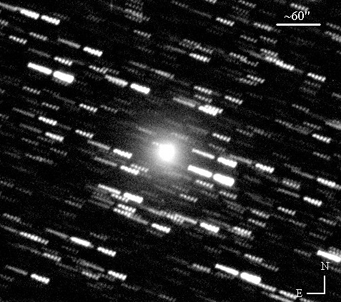Five amateur astronomers will share the 2009 Edgar Wilson Award for comets they discovered, according to an August 22nd announcement on IAU Circular 9066 from the Smithsonian Astrophysical Observatory's Central Bureau for Astronomical Telegrams (CBAT).

On April 6th, a trio of Italian observers captured Comet Yi-SWAN with a 10-inch reflector operated by Global-Rent-A-Scope near Mayhill, New Mexico. This is a stack of 10 exposures of 60 seconds each.
Ernesto Guido, Giovanni Sostero, and Paul Camilleri
Here's the list of winners, starting with the most recent find:
- Dae-am Yi (Korea), who discovered C/2009 F6, also known as Comet Yi-SWAN, on March 26, 2009. He used a Canon 5D camera and 90-mm f/2.8 telephoto lens.
- Koichi Itagaki (Japan), for capturing C/2009 E1 on March 14, 2009, with an 8.3-inch (21-cm) reflector at f/3.
- Michel Ory (Switzerland), for finding P/2008 Q2 on August 27, 2008, with a 24-inch f/3.9 reflector.
- Stanislav Maticic (Slovenia), for C/2008 Q1 on August 18, 2008, using a 24-inch f/3.3 telescope.
- Robert E. Holmes, Jr. (U.S.A.), for imaging C/2008 N1 on July 1, 2008, with a 16-inch f/5.8 Schmidt-Cassegrain telescope.
Robert Holmes, profiled here, runs a sophisticated patrol for near-Earth asteroids from his home in Charleston, Illinois. Don't confuse his find with another Comet Holmes — the one that literally burst into view in late 2007. That was a returning interloper, originally spotted by Edwin Holmes of London back in 1892. Robert's new Comet Holmes was a feeble magnitude 20.2 when he detected it — and that's much fainter than even the world's largest telescopes, amateur or professional, could have reached in 1892!
In fact, none of the current prizewinners' comets was at all spectacular when found. That's the take-away message, I think, for aspiring comet hunters of today. These successes relied on CCD detectors, not film or visual sweeps of the night sky. Technology marches on.
 1
1
Comments
Scott
August 28, 2009 at 4:59 pm
"In fact, none of the current prizewinners' comets was at all spectacular when found. That's the take-away message, I think, for aspiring comet hunters of today. These successes relied on CCD detectors, not film or visual sweeps of the night sky. Technology marches on."
I think a greater factor here other than being CCD equipped was aperture size. In all but one case, 16" or larger was reported for the discovery instruments aperture. Not to belittle the hard work of the award recipients, but having employed extra large apertures that most amateurs do not have access to sure didnât hurt their chances either.
I ran an NEO program for years but I couldnât keep up with the required aperture so I have subsequently moved on to exoplanets. Except for rare cases, the days of neo discovery with a 12" aperture have past; even follow-up work is nearly impossible now.
-Scott
You must be logged in to post a comment.
You must be logged in to post a comment.